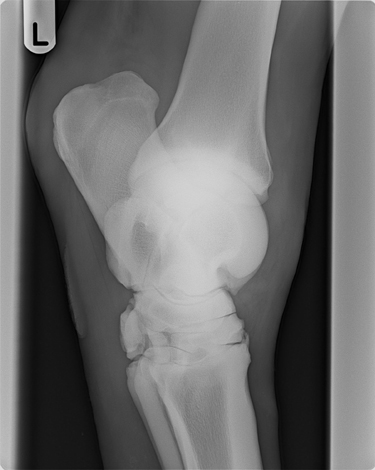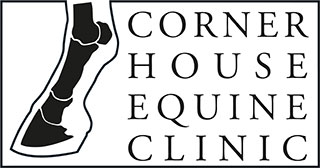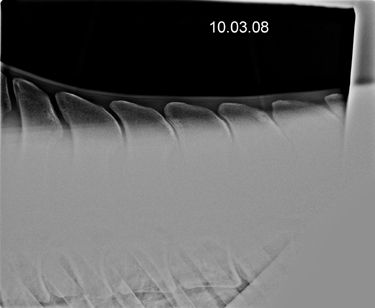Investigation of poor performance
History
Alfie is an 11-year-old Dutch Warmblood grey gelding and has been with his current owner/ rider, Sarah, for two years. Alfie started his athletic career as a show jumper but since his change of ownership has enjoyed eventing and affiliated dressage. Alfie and his rider have sailed through elementary dressage scoring in the high 60’s regularly.
Recently though, the schooling sessions have been more laboured and Alfie has struggled with the step-up to medium. There is reluctance to bend especially with right rein canter, he has become much heavier in the hand and has started to struggle with his changes. Sarah’s instructor trotted Alfie up and felt that he was sound and that he was possibly suffering with a back problem. The physiotherapist Maggie confirmed this as she found the horse to “locked up” through the neck, sore behind the saddle and tight in his hamstrings.
 Hock Lateral
Hock Lateral
We were requested to examine Alfie when carrying out routine vaccinations and teeth rasping at the livery yard. In trot Alfie was not obviously lame in a straight line but lacked impulsion from the hindquarters and occasionally dragged the toes on both hind legs. Alfie was prescribed with 10 days oral phenylbutazone (a painkilling and anti-inflammatory drug) as a trial to see if the lack of performance was due to orthopaedic pain. Within 3 to 4 days Alfie did not put his ears back when Sarah was tacking him up and did not show reluctance to go on a hack and once warmed up properly was light in the hand and schooled well on both reins.
Diagnosis
Alfie came into the clinic a week later. The painkilling medication had been withdrawn so that the symptoms were not disguised. Horses cannot compete in affiliated competitions on medication that alters the performance and therefore it was necessary to achieve a specific diagnosis. Alfie was walked and trotted in a straight line, lunged on a circle on hard standing and on the soft surface. Detailed notes were taken at each stage and flexion tests were performed. Although sound in a straight line Alfie was found to be lame on a circle on both reins on both hind legs. The lameness was made worse with flexion of the hocks. Hock x-rays revealed advanced arthritis in the lower hock joints (spavin). These joints are low-motion joints and are involved in torsional movement. When lunged in the ménage the horse was very “stilted” through the back (thoraco-lumbar spine) and its head and neck were bent to the outside on each rein. There was a reluctance to bend or flex through the saddle area when this area was palpated. The back was also radiographed.
The dorsal spinous processes (DSP’s) were crowded with mild impingement. There was evidence of soft tissue pain with spasm in the epaxial muscles of the spine (top line).
A diagnosis of hock arthritis and secondary back pain was made. Local anaesthetic was injected into the tarsometatarsal joints (lower hock joints) and the horse was sound on both reins within 10 –15 minutes. Which chronic low-grade lameness that affects both hindlegs the lameness was not evident for the lay-person. The gelding compensated for the pain by altering its gait and dipping the back (lordosis) giving rise to the back pain.
Treatment
This horse was treated with an intravenous drip of Tildren®. This drug modifies the metabolism of bone and is useful in treating advanced arthritis of low-motion joints by stopping the breakdown of bone tissue and by increasing the production of new bone. It also has a marked pain-killing affect. The back pain was treated using 3 sessions of Extra-corporeal Shock Wave Therapy (EWST) 7-10 days apart. This relieves spasm and pain in soft tissue structures, increases blood flow and mobility in the affected area. The gelding also received an intra muscular course of Adequan® to help maintain healthy joints through the whole of the skeletal structure.
Alfie was kept out of the dressage arena for 6 weeks. The controlled exercise programme consisted of hacking at walk in straight lines alternated with long-reining for 2 weeks, building up to 1 hour daily of walk, trot and canter in straight lines over the following 4 weeks. Staying in straight lines removes any torsional strain on the lower hock joints and the long-reining helps build up the top-line and core muscle groups.
Alfie is now back competing at elementary dressage without needing “bute” to keep him sound.


